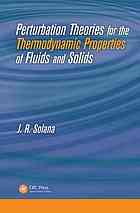Product desciption
Perturbation Theories For The Thermodynamic Properties Of Fluids And Solids J R Solana by J R Solana 9781439807767, 1439807760 instant download after payment.
"This book, Perturbation Theories for the Thermodynamic Properties of Fluids and Solids, provides a comprehensive review of current perturbation theorie--as well as integral equation theories and density functional theorie--for the equilibrium thermodynamic and structural properties of classical systems. Emphasizing practical applications, the text avoids complex theoretical derivations as much as possible. It begins with discussions of the nature of intermolecular forces and simple potential models. The book also presents a summary of statistical mechanics concepts and formulae. In addition, it reviews simulation techniques, providing background for the performance analyses of theories executed throughout the text using simulation data.Chapters describe integral equation theories, theoretical approaches for hard-sphere fluid or solid systems, and perturbation theories for simple fluids and solids for monocomponent and multicomponent systems. They also cover density functional theories for inhomogeneous systems and perturbative and nonperturbative approaches to describe the structure and thermodynamics of hard-body molecular fluids. The final chapter examines several more challenging systems, such as fluids near the critical point, liquid metals, molten salts, colloids, and aqueous protein solutions.This book offers a thorough account of the available equilibrium theories for the thermodynamic and structural properties of fluids and solids, with special focus on perturbation theories, emphasizing their applications, strengths, and weaknesses. Appropriate for experienced researchers as well as postgraduate students, the text presents a wide-ranging yet detailed view and provides a useful guide to the application of the theories described"--
Content: Introduction Aggregation States of Matter Nature of the Intermolecular Forces Simple potential models Some Basics on Statistical Mechanics Virial Theorem and the Equation of State Distribution functions Thermodynamic Properties in Terms of the Radial Distribution Function Static Structure Factor Overview of Computer Simulation Methods Computer Simulations Monte Carlo Method Molecular Dynamics Method Some Technical Details Thermodynamic and Structural Properties from Computer Simulation Computer Simulation of Phase Equilibria Integral Equation Theories Ornstein-Zernike Equation Closure Conditions Universality of the Bridge Function Integral Equation Perturbation Theories Some Results from Integral Equation Theories for Selected Potential Models The Radial Distribution Function and Equation of State of the Hard-Sphere Fluid and Solid Fluid and Solid Phases in the Hard-Sphere System Scaled Particle Theory Solution of the Percus-Yevick Equation Rational Function Approximation First-Order Mean Spherical Approximation Equation of State and Radial Distribution Function of the Hard-Sphere Solid Free Energy Perturbation Theories for Simple Fluids and Solids Series Expansion of the Free Energy Calculation of the Perturbation Terms by Computer Simulation Perturbation Theories for Hard-Core Potentials Perturbation Theories for Soft-Core Potentials Mode Expansion Hierarchical Reference Theory Using Non-Hard-Sphere Reference System Results for Some Potential Models Perturbation Theories for Simple Fluid Mixtures Real and Ideal Mixtures Conformal Mixtures n-Fluid Models for Conformal Mixtures Extension to Mixtures of Perturbation Theories for Monocomponent Systems Mixtures of Additive Hard Spheres Mixtures of nonadditive Hard Spheres Other Simple Mixtures Perturbation Theories for Molecular Fluids Extension of the Free Energy Perturbation Theory to Fluids with Anisotropic Interactions Scaled-Particle-Like Approaches for Hard-Body Molecular Fluids Percus-Yevick Theory for Hard-Sphere Chain Fluids Generalized Flory Theories for Hard-Sphere Chain Fluids Wertheim's Perturbation Theory for Hard-Sphere Chain Fluids Extensions to Linear Fused Hard-Sphere Chains Perturbation Theories for Molecular Fluids with Dispersive Forces Non-Isotropic Phases Inhomogeneous systems Fundamentals of the Density Functional Formalism Some Density Functional Approximations Fundamental Measure Theory Simple Fluids and Solids Surfaces and Interfaces Inhomogeneous Systems with Anisotropic Interactions Overview to Perturbation Theories for More Complex Systems Fluids near the Critical Point Liquid Metals, Molten Salts, and Electrolyte Solutions Colloids and Colloid-Polymer Mixtures Aqueous Protein Solutions Index
Abstract: "This book, Perturbation Theories for the Thermodynamic Properties of Fluids and Solids, provides a comprehensive review of current perturbation theorie--as well as integral equation theories and density functional theorie--for the equilibrium thermodynamic and structural properties of classical systems. Emphasizing practical applications, the text avoids complex theoretical derivations as much as possible. It begins with discussions of the nature of intermolecular forces and simple potential models. The book also presents a summary of statistical mechanics concepts and formulae. In addition, it reviews simulation techniques, providing background for the performance analyses of theories executed throughout the text using simulation data.Chapters describe integral equation theories, theoretical approaches for hard-sphere fluid or solid systems, and perturbation theories for simple fluids and solids for monocomponent and multicomponent systems. They also cover density functional theories for inhomogeneous systems and perturbative and nonperturbative approaches to describe the structure and thermodynamics of hard-body molecular fluids. The final chapter examines several more challenging systems, such as fluids near the critical point, liquid metals, molten salts, colloids, and aqueous protein solutions.This book offers a thorough account of the available equilibrium theories for the thermodynamic and structural properties of fluids and solids, with special focus on perturbation theories, emphasizing their applications, strengths, and weaknesses. Appropriate for experienced researchers as well as postgraduate students, the text presents a wide-ranging yet detailed view and provides a useful guide to the application of the theories described"


